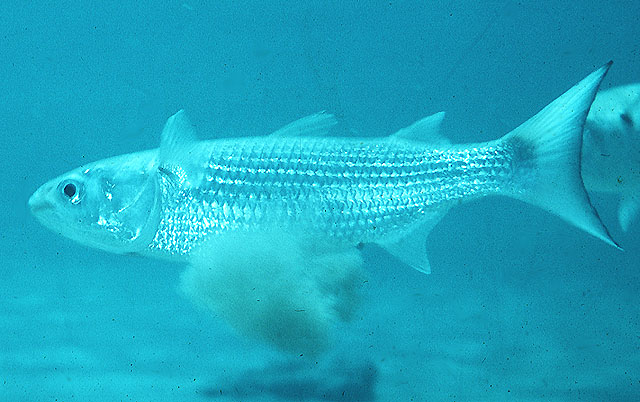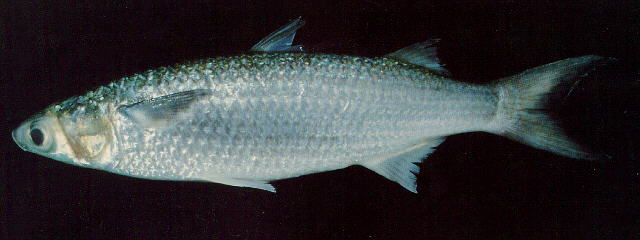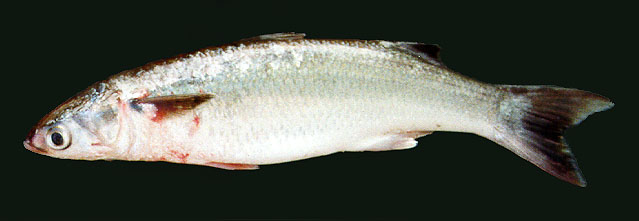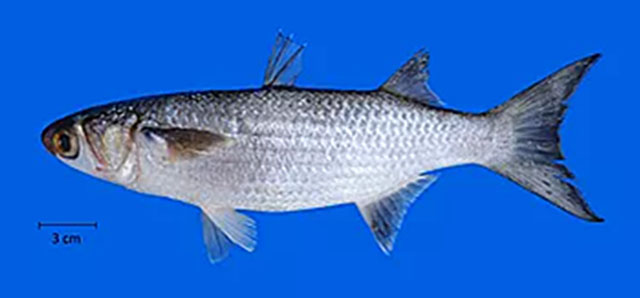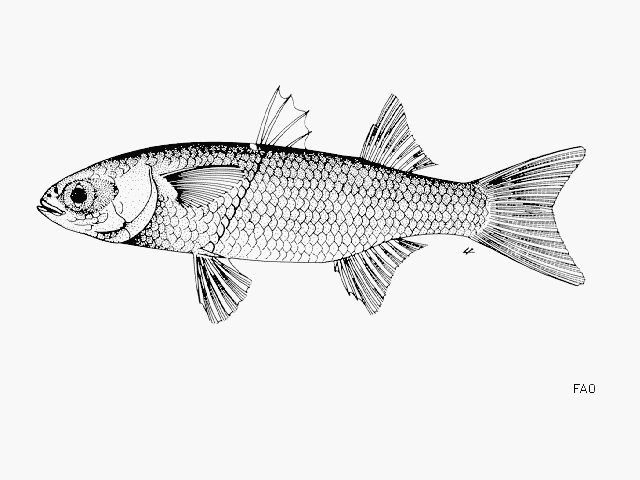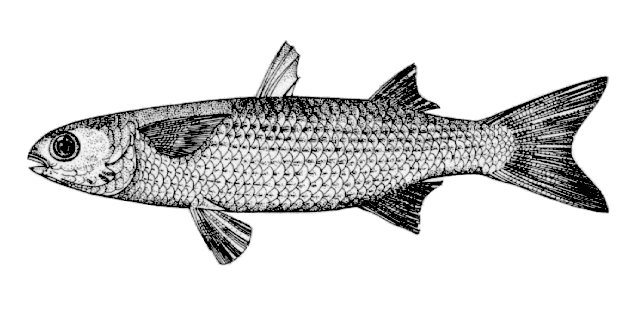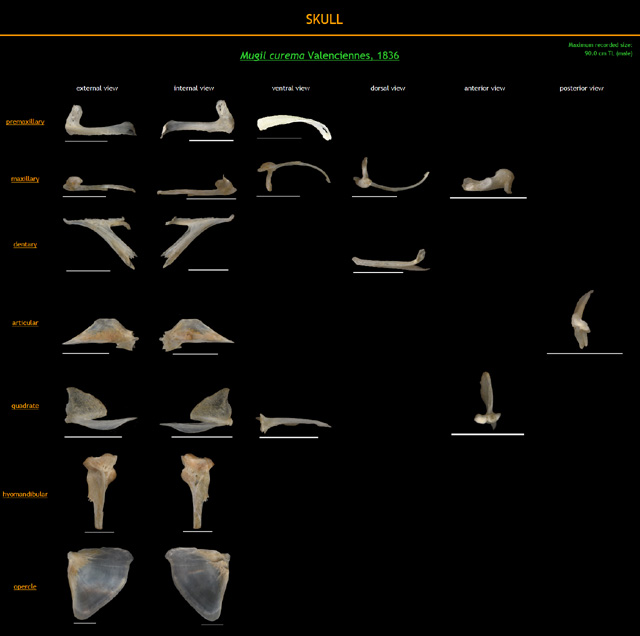Mugil
curema
Valenciennes,
1836
White mullet
View all media / Upload your photos and videos
Expand all
Classification / Names
Teleostei (teleosts) > Mugiliformes (Mullets) >
Mugilidae (Mullets)
Etymology: Mugil: Latin, mugil, -ilis = grey mullet (Ref. 45335).
More on author:
Valenciennes.
Environment / milieu / depth range / climate zone / distribution range
Marine; brackish; freshwater; reef-associated; catadromous (Ref. 51243); depth range 0 - 300 m usually 0 - 20 m; subtropical; 43°N - 34°S114°W - 16°E.
Distribution
Maps

Mugil curema / Native range
AquaMaps Data sources:
GBIF
OBIS
This map was computer-generated and has not yet been reviewed.

Mugil curema / Suitable habitat
AquaMaps Data sources:
GBIF
OBIS
This map was computer-generated and has not yet been reviewed.

Mugil curema / Point map
AquaMaps Data sources:
GBIF
OBIS
This map was computer-generated and has not yet been reviewed.

Mugil curema / Year 2050
AquaMaps Data sources:
GBIF
OBIS
This map was computer-generated and has not yet been reviewed.
Length at first maturity / Size / Weight / Age
Short description
Dorsal spines (total): 4 - 5; Dorsal soft rays (total): 8 - 9; Anal spines: 3; Anal soft rays: 9 - 10. Diagnosis: body stout, rounded in cross-section; head broad; inter-orbital space flat; a well developed adipose eyelid covering most of pupil (Ref. 57400). Upper lip simple, thicker and deeper than in most Mugil species, armed with 2-3 rows (Ref. 57400), teeth in outer row curved, monocuspid (Ref. 57400, 81659) and moderately close-set (Ref. 81659) or widely spaced (Ref. 57400), inner row of less closely set, smaller teeth may be present just posterior to outer row (Ref. 81659). Lower lip with single row of unicuspid teeth, usually smaller than teeth in outer row on upper lip (Ref. 81659). A vertical line from hind end of upper jaw positioned midway between posterior nostril and anterior eye margin; maxillary pad not visible below corner of mouth when closed; origin of 1st dorsal fin equidistant from snout tip and caudal-fin base; pectoral axillary process well developed (30-37% of pectoral-fin length)(Ref. 57400). (Second) dorsal and anal fins entirely (and more or less densely) covered with scales (Ref. 57400, 81659). Anal fin usually III-9 (rarely III-10) in adults (usually II-10 in juveniles <30 mm SL), first spine very short and usually hidden by overlying scales (Ref. 81659). 11-13 scale rows between origins of first dorsal and pelvic fins (Ref. 57400, 81659). Description: 32-39 (usually 35 or 36) scales in longitudinal series (excluding scales on caudal fin base)(Ref. 81659), usually 38-39 scales in lateral series (Ref. 26938). Scales on side covered with smaller secondary scales (Ref. 26938). Scales covering entire second dorsal and anal fins in adults, fins less heavily scaled in specimens <50 mm SL; pectoral fin 70-85% of head length, with 1 short, unsegmented ray dorsally and 14-17 longer, segmented rays; pharyngobranchial organ with single, large valve, often longer (anteroposteriorly) than deep (dorsoventrally)(Ref. 81659). Coloration: live specimens: bluish green or olive dorsally, flanks silvery and abdomen off-white; yellowish blotch between eye and upper edge of opercle (Ref. 81659). Dorsal fins translucid (Ref. 57400) with numerous, fine, black speckles on and between rays, second dorsal fin sometimes slightly darker than first (Ref. 81659). Caudal fin yellowish at base, with fine black speckles on and between rays (Ref. 81659) and blackish distal margin (Ref. 57400, 81659). Anal and pelvic fins paler than dorsal fins (Ref. 81659) and may be yellowish (Ref. 57400, 81659). Pectoral fin speckled with fine black spots, but paler than dorsal fins (Ref. 81659). Dark spot dorsally at origin of pectoral fin (Ref. 57400, 81659). Preserved specimens: may be dark brown, with darker patches on dorsal parts of flanks adjacent to first dorsal fin and anteriorly on nape and occiput (Ref. 81659).
Biology
Inhabit sandy coasts and littoral pools but also occurs in muddy bottoms of brackish lagoons and estuaries. Sometimes penetrate rivers. May also be found on coral reefs (Ref. 9710). Juveniles are common in coastal waters and are known to find their way to estuaries and coastal lagoons. Growth in juveniles is moderate (30-40 cm in 4 years). Adults form schools (Ref. 9321). Feed on microscopic or filamentous algae and small juveniles of planktonic organisms (Ref. 9626). Reproduction occurs between March and August. Spawn several million eggs provided with a notable yolk (Ref. 35237). Oviparous, eggs are pelagic and non-adhesive (Ref. 205). Maximul size 910 mm TL for western Central Atlantic specimens, eastern Central Atlantic specimens may reach 350 mm TL and commonly reach 250 mm TL (Ref. 81659). An important foodfish, it is marketed fresh and salted (Ref. 9321).
Main reference
Robins, C.R. and G.C. Ray 1986 A field guide to Atlantic coast fishes of North America. Houghton Mifflin Company, Boston, U.S.A. 354 p. (Ref. 7251)
IUCN Red List Status (Ref. 125652)
Least Concern (LC); date assessed: December 21 2018
CITES (Ref. 131153)
Not Evaluated
CMS (Ref. 116361)
Not Evaluated
Threat to humans
Harmless
More information
- Countries
- FAO areas
- Ecosystems
- Occurrences
- Introductions
- Stocks
- Ecology
- Diet
- Food items
- Food consumption
- Ration
- Common names
- Synonyms
- Metabolism
- Predators
- Ecotoxicology
- Reproduction
- Maturity
- Spawning
- Spawning aggregation
- Fecundity
- Eggs
- Egg development
- Age/Size
- Growth
- Length-weight
- Length-length
- Length-frequencies
- Morphometrics
- Morphology
- Larvae
- Larval dynamics
- Recruitment
- Abundance
- References
- Aquaculture
- Aquaculture profile
- Strains
- Genetics
- Allele frequencies
- Heritability
- Diseases
- Processing
- Mass conversion
- Vision
- Pictures
- Stamps, Coins Misc.
- Sounds
- Ciguatera
- Speed
- Swim. type
- Gill area
- Otoliths
- Brains
Estimates based on models
Preferred temperature (Ref. 123201): 21 - 28, mean 26.1 °C (based on 798 cells).
Phylogenetic diversity index (Ref. 82804): PD50 = 0.5 [Uniqueness, from 0.5 = low to 2.0 = high].
Bayesian length-weight: a=0.01175 (0.01005 - 0.01373), b=2.95 (2.92 - 2.98), in cm total length, based on LWR estimates for this species (Ref. 93245).
Trophic level (Ref. 69278): 2.0 ±0.0 se; Based on diet studies.
Resilience (Ref. 120179): Medium, minimum population doubling time 1.4 - 4.4 years (tm=2-3; Fec=>50,000).
Fishing vulnerability (Ref. 59153): High vulnerability (56 of 100).
Price category (Ref. 80766): Medium; Very questionable: based on ex-vessel price for species in this family.
Nutrients (Ref. 124155): Calcium = 41.8 [12.1, 129.8] mg/100g; Iron = 1.16 [0.21, 6.72] mg/100g; Protein = 20.4 [18.6, 22.0] %; Omega3 = 0.289 [0.115, 0.777] g/100g; Selenium = 47.2 [14.8, 166.0] μg/100g; VitaminA = 23.8 [5.1, 118.5] μg/100g; Zinc = 1.75 [0.78, 4.50] mg/100g (wet weight);

